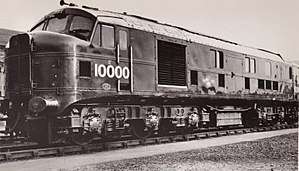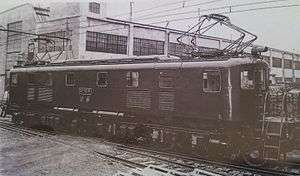Co-Co locomotives
Co-Co is the wheel arrangement for a diesel locomotive with two six-wheeled bogies with all axles powered, with a separate traction motor per axle. The equivalent UIC classification (Europe) for this arrangement is Co′Co′ or C-C for AAR (USA).
Use
Co-Cos are most suited to freight work as the extra wheels give them good traction. They are also popular because the greater number of axles results in a lower axle load to the track.[1]
History

The first mainline diesel-electric locomotives were of Bo-Bo arrangement. As they grew in power and weight, from 1937 the EMD E-units used an A1A-A1A layout with six axles to reduce axle load, but only four of them were powered. After WWII, the British LMS ordered two prototype locomotives with some of the first Co-Co arrangements.
.jpg)
The very first C-C design recorded was a narrow-gauge Hornsby opposed-piston Hornsby-Akroyd-engined locomotive of 1903 for the Chattenden and Upnor Railway. There was a two-speed mechanical transmission with drive shafts to the bogies and the axles on each bogie were linked by coupling rods.[2]
Variants
Electric locomotives

There were initially few electric locomotives with this wheel arrangement, as they are usually lighter than diesel-electrics of similar power and so could manage a similar axle loading with a simpler Bo-Bo arrangement. Some of the few early examples were the French CC 7100 of 1949 and the British Railways EM2 of 1953.

As high-speed electric locomotives in the 1980s began to achieve powers in the 6,000 hp range, new Co-Co designs appeared, as more axles were needed to distribute this high power. The BR class 92 was a predominantly freight locomotive of this arrangement for the Channel Tunnel, although the passenger Eurotunnel Class 9 instead use a Bo-Bo-Bo arrangement. This provides the same number of axles for traction, although with shorter bogie wheelbases and so gives a smoother ride.
C-C
In C-C (Commonwealth) or C′C′ (UIC) arrangements, the axles of each bogie are coupled together. This may be for either a diesel-hydraulic transmission with a mechanical drive shaft to the bogie and final drives to each axle. Otherwise a monomotor bogie with a single traction motor. These are used for both electrics and diesel-electrics.
In AAR notation, the notation is the same for both variants and cannot distinguish them. However hydraulic transmissions are almost unknown in the US, the Krauss-Maffei ML 4000 and the ALCO DH643 being the only C′C′ examples.
Co+Co

Co+Co is the code for a similar wheel arrangement but with an articulated connection between the bogies. The buffer and drawbar forces are taken between the bogies rather than through the frame. These were mostly popular in South Africa.
1Co-Co1
The 1Co-Co1 wheel arrangement is an alternative to the Co-Co arrangement which has been used where it was desired to reduce axle load. Each "Co" bogie has an additional non-powered axle in an integral pony truck to spread the load. As the pony truck is articulated within the bogie,[3] the arrangement is (1′Co)(Co1′) in UIC notation.
This rare arrangement was only used in Britain, in designs originating from the Southern Railways' first three prototype mainline diesel-electric designs, 10201–10203.[4] This bogie design was then repeated in the class 40 and Peak classes.[3][5] A few were built for export, also by English Electric, such as the DE2 for Rhodesia Railways.
1Co+Co1

1Co+Co1, like Co+Co, is an articulated variant where the drawbar forces are taken between the bogies rather than through the frame. These were used in South Africa, for lighter loadings on the lightly-laid 3 ft 6 in (1,067 mm) Cape gauge. A number of Japanese electrics from the 1930s, also on Cape gauge, such as the EF10 also used this arrangement.
2Co-Co2
The New Zealand DF class were built in the mid-1950s by English Electric in Britain, as the first diesels for the 3 ft 6 in (1,067 mm) New Zealand railways. They were derived from the earlier English Electric 1Co-Co1 bogie design, but to provide increased flexibility for the long wheelbase bogie they used a four-wheeled bogie with more sideplay, rather than a pony truck.
Examples
Notable Co-Co examples include the British Rail Class 47, the Soviet M62 locomotive and the EMD Series 66, mainstay of many current European heavy rail haulage fleets, over 500 having been built to date. The very strong IORE locomotive has this also, but to allow higher locomotive weight, 30 tonnes per axle.
References
| Wikimedia Commons has media related to Co′Co′ locomotives. |
- Lee, Robert (2007). The Railways of Victoria 1854-2004. Melbourne University Publishing. p. 212. ISBN 978-0-522-85134-2.
- Webb, Brian (1973). The British Internal Combustion Locomotive, 1894-1940. David & Charles. p. 19. ISBN 0715361155.CS1 maint: ref=harv (link)
- Webb, Brian (1978). "Class 44". Sulzer Diesel Locomotives of British Rail. David & Charles. p. 30. ISBN 0715375148.CS1 maint: ref=harv (link)
- Clough, David N. (2005). "Pre-Nationalisation Prototypes". Southern Railway prototypes Nos 10201–3. Diesel Pioneers. Ian Allan. p. 11. ISBN 978-0-7110-3067-1.
- Clough, David N. (2009). Class 40. British Rail Standard Diesels of the 1960s. Ian Allan. pp. 94–100. ISBN 978-0-7110-3373-3.
.jpg)
.jpg)

.jpg)